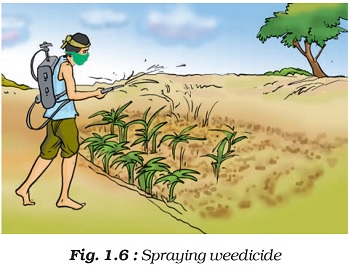1.7 Protection from Weeds
NCERT Class 8 Science Textbook for Blind Students made Screen Readable by Dr T K Bansal.
Boojho and Paheli went to a nearby wheat field and saw that there were some other plants in the field, growing along with wheat plants.
Have these other plants been planted purposely?
In a field many other undesirable plants may grow naturally along with the crop. These undesirable plants are called weeds.
The removal of weeds is called weeding. Weeding is necessary since weeds compete with the crop plants for water, nutrients, space and light. Thus, they affect the growth of the crop. Some weeds interfere even in harvesting and may be poisonous for animals and human beings.
Farmers adopt many ways to remove weeds and control their growth. Tilling before sowing of crops helps in uprooting and killing of weeds, which may then dry up and get mixed with the soil. The best time for the removal of weeds is before they produce flowers and seeds. The manual removal includes physical removal of weeds by uprooting or cutting them close to the ground, from time to time. This is done with the help of a khurpi. A seed drill [Figure 1.2(b)] is also used to uproot weeds.
Weeds are also controlled by using certain chemicals, called weedicides, like 2, 4-D. These are sprayed in the fields to kill the weeds. They do not damage the crops. The weedicides are diluted with water to the extent required and sprayed in the fields with a sprayer. (Figure 1.6).
Figure 1.6 : Spraying weedicide

Do weedicides have any effect on the person handling the weedicide sprayer?
As already mentioned, the weedicides are sprayed during the vegetative growth of weeds before flowering and seed formation. Spraying of weedicides may affect the health of farmers. So they should use these chemicals very carefully. They should cover their nose and mouth with a piece of cloth during spraying of these chemicals.
